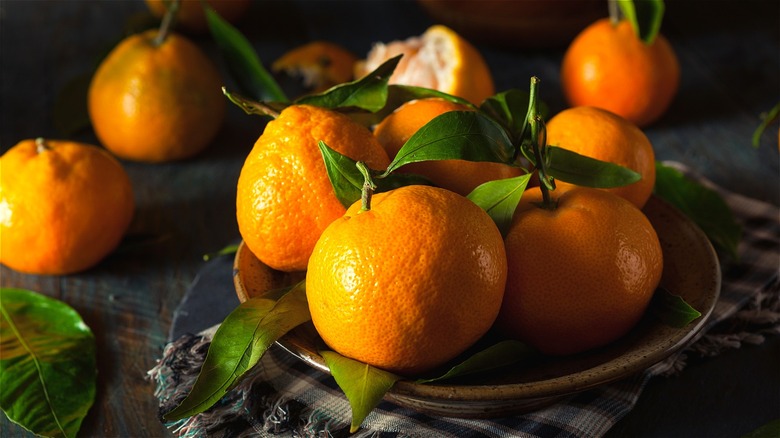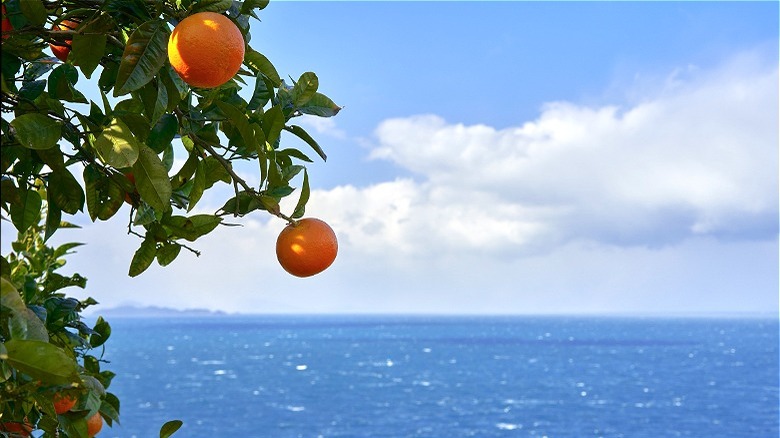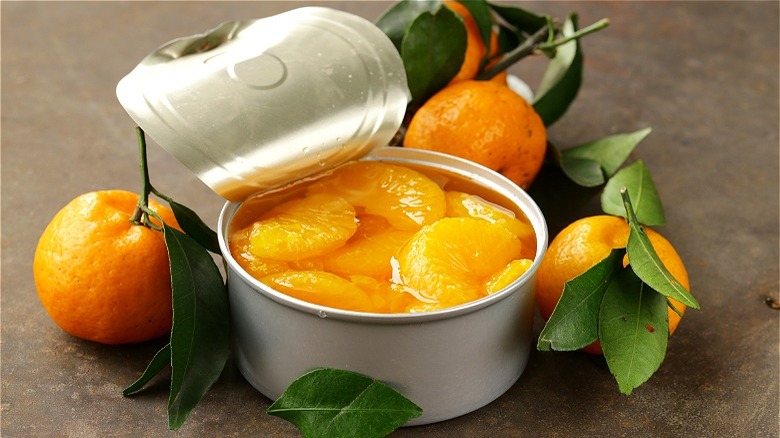What Makes Satsuma Mandarins So Unique?
Grocery shoppers who enjoy varied fruits and vegetables often seek out seasonal-specific produce throughout the year — there's nothing quite like biting into a zesty, acidic orange or tangerine upon entering the throes of the winter season. And luckily for Americans, Spoons Across America claims the most common citrus varieties like lemons and navel oranges are available year-round. That would make sense given the fact that the USDA reports citrus fruits upheld 14% of Americans' potential fruit intake in 2018.
Despite the reliable presence of regular citrus fruits in grocery stores, there are many more to choose from, especially when smaller fruits make their yearly debut on market shelves during the winter months (via Food Network). According to S and J Mandarin Grove, oranges and mandarins fall into two separate categories. While oranges are larger and have more of an acidic flavor and thicker skin, mandarins are smaller in size and much easier to peel.
Bloomberg states that oranges have always been the most consumed citrus fruit in America, averaging nine pounds of consumption per person every year, but mandarins are predicted to surpass those statistics by 2025 due to their easy peeling and on-the-go accessibility. Clementines, tangerines, and Satsumas are all different varieties of mandarins but there are a few special characteristics that set Satsumas apart from the rest of their citrus family members.
Where did Satsuma mandarins originate?
Before we dive into the fun facts that set Satsumas apart from their veritable cousins, let's take a look at their long-ago beginning overseas and more importantly, how they became so popular here in America. According to Specialty Produce, satsumas originally came from China and then made their everlasting home in Japan sometime in the 1300s. You probably didn't know that these small, brightly flavored fruits were never supposed to be called Satsumas in the first place.
Originally labeled as "Unshu" citrus, once these fruit-producing trees started arriving in the United States from Japan in the late 19th century from one U.S. minister General Van Valkenberg, the University of Florida IFAS Extension claims the far-away boxes were labeled with the province they came from and in this case, derived from a province in Japan called Satsuma, located on the edge of Kyushu Island. In one 2017 study, Satsumas were noted to arrive in the U.S. in 1876 and by the year 1911, millions of trees were being imported from Japan and planted along the Gulf coast states from Florida to Texas. Specialty Produce notes that U.S.-born Satsumas are now primarily grown in California. Before preparing another citrus salad with fresh mint, you may want to develop your appreciation for this small accessible fruit and there are plenty of unique elements (beyond their accidental name) that set Satsumas apart from the rest of the citrus clan.
The unique qualities of Satsuma mandarins
Joan Wickham, director of communications at Sunkist Growers claims Satsuma mandarins have a "sweet aroma with a refreshing flavor that is warm and tropical" (per Produce Business). And Besties describes Satsumas as small, round, and seedless citrus fruits, capable of handling considerably cold temperatures. Apart from being able to thrive in frigid weather, the fruit has been known to ripen before the outer skin turns orange and has undoubtedly become a healthy convenient snack option for many fresh fruit lovers over the years due to its thin, easily peeled skin. Specialty Produce states this thin skin makes them more fragile since the chances of bruising are much higher than in other varieties. Not only are Satsumas enjoyed raw due to convenience but Specialty Produce claims they are known as the sweetest citrus variety, often bursting with excessive juiciness.
With the abundance of juice, did you know Satsumas are the number one variety used in packaged mandarins? According to the Ontario marketing association (via The Packer), Satsumas hold their juice and shape well in the production process, thus becoming the leader in packaged varieties sold in stores. Mandarins aren't ripe for eating year-round, however, they are typically available only between fall and late winter (per Specialty Produce). While these facts may not add anything to your favorite citrus recipes, you can hopefully appreciate the one-of-a-kind qualities of Satsuma mandarins and continue to enjoy them as a sweet, convenient snack when available.


